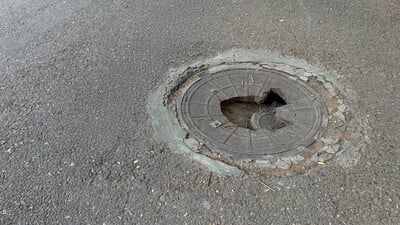Selecting the correct manhole cover size is crucial for safety and durability. Manhole covers must fit securely to prevent structural failure, and different sizes and shapes suit different applications.
In this article, we talk about the most common manhole cover shapes and sizes, and what they are typically used for. We also explain their different load classes; an important factor in ensuring safety and long-term durability.
Manhole Cover Shapes & Their Uses
Square & Rectangular Covers
Square and rectangular covers are widely used in urban and industrial areas due to their ease of installation in modular paving. They fit neatly into road and pavement layouts and are commonly seen in city streets and commercial zones.
Circular Covers
Circular covers are the most common in roads and highways as they prevent accidental misalignment. Unlike square covers, they cannot fall into the hole they cover, making them safer for high-traffic areas. These are often used in main sewer systems and underground electrical vaults.
Recessed Covers
Recessed manhole covers allow paving material such as block paving, stone, tarmac, loose and resin-bound aggregate to be placed within their frame so that the manhole blends seamlessly into its surroundings. They can also be used for the same purpose in soft landscaped areas, where they can hold soil, mulch or turf. These are commonly found in driveways, pavements and landscaped areas where appearance is important.
Hinged Covers
Hinged covers provide easy access and increased security. They are often used in utility networks, including electrical, water and telecom infrastructure, where frequent access is required.
Common Manhole Cover Sizes
Square and rectangular manhole covers typically range from 300mm x 300mm to 1200mm x 1200mm. Circular covers are usually 450mm or 600mm in diameter but can be larger for specific industrial uses.
Square & Rectangular Manhole Covers
300mm x 300mm
This compact size is commonly found in pedestrian areas where only foot traffic is expected. It is often used for small inspection chambers in gardens, parks and footpaths. These covers provide access to underground telecoms or irrigation system junctions.
450mm x 450mm
Slightly larger, this size is suitable for light-use residential applications, including small service access points on private property. It is commonly used for water meters, cable access points and minor drainage inspection chambers.
600mm x 450mm
Rectangular covers of this size are frequently seen in roadways and pavements where narrow but elongated access is required. They are commonly used for utility service tunnels, including gas and electrical conduits.
600mm x 600mm
A standard size for urban roads and residential driveways, 600mm x 600mm covers are built to withstand moderate vehicle loads. They are commonly used in public spaces, car parks and light-traffic roads, where they provide access to sewer systems, electrical junctions and telecoms infrastructure.
900mm x 600mm
This size is commonly used in industrial and commercial sites where larger underground chambers need access. It provides entry to drainage systems, gas mains and cable tunnels that require more working space.
900mm x 900mm
These larger covers are designed for industrial and commercial sites where heavier traffic is expected. They provide access to major drainage networks, gas pipeline access points and larger telecoms hubs that require maintenance access for multiple cables and conduits.
1200mm x 900mm
Used for large-scale infrastructure, such as highways and industrial yards, this rectangular size accommodates wide access points for maintenance teams working on storm drains, electrical vaults and underground storage tanks.
1200mm x 1200mm
This size is primarily used for major municipal drainage systems and extensive underground utilities, including wastewater treatment pipelines and large electrical transformer enclosures.
Circular Manhole Covers
450mm
A common size for pedestrian areas, small roadways and residential applications, where they are frequently used for water supply access points, telecoms maintenance chambers and small sewage access.
600mm
This is the standard size for urban roads and highways, where it is used for sewer maintenance, electrical cable chambers and major telecom infrastructure.
900mm
Typically found in industrial zones, this cover size provides access to large sewer systems, stormwater drainage networks and underground cable chambers. It is also used in transport depots and freight terminals where larger underground service tunnels require maintenance access.
Manhole Cover Materials
Manhole covers are manufactured from different materials depending on their load-bearing requirements and environmental conditions.
Cast Iron
Cast iron is a traditional and highly durable material used for manhole covers in roads and high-traffic areas. It has excellent load-bearing strength and a long lifespan, making it ideal for main roads and highways.
Ductile Iron
Ductile iron is a modern alternative to cast iron that offers greater strength while being lighter in weight. It is often used in high-traffic and industrial applications, where durability and resistance to heavy loads are essential.
Galvanised Steel
Galvanised steel covers are resistant to corrosion and are often used in pedestrian and light vehicle zones. They are lighter than iron covers, which makes them more suitable for manholes that require frequent maintenance access.
Stainless Steel
Stainless steel is highly corrosion-resistant and offers a sleek appearance, making it ideal for commercial spaces, indoor applications and locations where hygiene is a priority, such as food production facilities.
Composite Materials
Composite covers are made from a blend of fibreglass and resin, providing a lightweight, non-conductive and corrosion-resistant alternative. These are used in telecoms, electrical installations and areas where metal theft is a concern.
Concrete
Concrete covers are used in stormwater drainage systems and other non-traffic applications. Their weight makes them secure, but they are not suitable for areas with heavy vehicle loads.
Load Classifications for Manhole Covers
Various classification systems exist to determine the weight a manhole cover can withstand. The most used systems are Class A to F and A15 to F900.
Load Classification Table
| Load Class | Max Static Load (Tonnes) | Max Dynamic Load (Tonnes) | Typical Materials |
| A15 (Class A) | 1.5 | 1.0 | Composite, Galvanised Steel |
| B125 (Class B) | 12.5 | 10 | Galvanised Steel, Composite |
| C250 (Class C) | 25 | 20 | Ductile Iron, Composite |
| D400 (Class D) | 40 | 35 | Ductile Iron, Cast Iron |
| E600 (Class E) | 60 | 55 | Ductile Iron, Steel-Reinforced Composite |
| F900 (Class F) | 90 | 85 | Ductile Iron, Stainless Steel |
Load Classification by Use
Pedestrian & Residential Areas (A15, B125)
For areas where only foot traffic or light vehicle use is expected, A15 and B125 covers are suitable. They are ideal for gardens, footpaths, driveways and residential areas where cars and vans are the heaviest loads they will bear.
Urban & Light Traffic Areas (C250)
C250 covers are used in areas with occasional traffic, such as small car parks, service lanes and residential streets. They provide a balance between durability and accessibility. We mostly upgrade customers to D400 covers as they work out more cost effective, despite being able to withstand a higher load.
Main Roads & Highways (D400)
D400 covers are essential for roads, highways, and other areas where regular heavy vehicle traffic is expected. They are commonly seen in city streets, on motorways and along public transport routes.
Industrial & Commercial Areas (E600)
For loading bays, warehouses and commercial spaces with frequent heavy goods vehicle traffic, E600 covers offer the necessary strength and durability.
Extreme Heavy Duty Areas (F900)
F900 covers are designed for airports, docks and container terminals, where extremely heavy loads, such as aircraft and freight trucks, regularly pass over them.
The Importance of Getting It Right
Choosing the right manhole cover requires careful consideration of size, material and load classification.
Ensuring the correct fit and strength will improve safety and longevity, whether for residential, commercial or heavy-duty applications.
Always select a cover that meets or exceeds the required load classification to ensure durability and reliability.
We hope you find this guide useful. If you have any further questions about manhole covers, you’re welcome to contact us at Drainfast where our technical experts will be pleased to help you.

Written by
Bob Stone
Technical Sales
Heading up our Technical Estimating Department, Bob is our in-house quantity surveyor.

